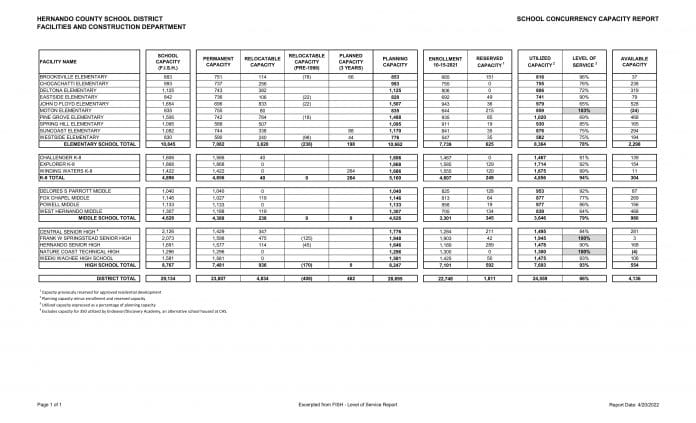Jim Lipsey, Manager of Planning, Design, and Construction appeared at the Hernando County School District’s (HCSD) Workshop on May 10, 2022, to present the impact future residential development will have on county schools. The information stems from the information presented at the Planning and Growth Management Committee meeting on April 6, 2022.
Lipsey began by showing areas of the county that are actively developing, areas approved for conditional plat — meaning those areas that are already being calculated in growth planning. He also showed areas that have applied for rezoning and the future outlook for potential properties that haven’t applied with the Planning and Zoning Commission yet.
“All told, with these six developments, there are 900 dwelling units currently under construction. When you figure out student generation rate on average is one student per every three homes, that translates to 319 students.” He added that in 2020, 493 dwelling units were added to the county, generating an estimated 165 students. In 2021, 2,264 dwelling units were approved, which translated to 750 students, according to the 1 student to 3 homes ratio.
Lipsey’s current projection is a countywide total of 5,088 potential dwelling units, which equates to 1,697 students added to the school system if all approved dwelling units are built.
Board Member Susan Duval asked about predictions for grade levels. Lipsey reported that by taking historical averages, he estimated 46% are typically elementary students, 23% are in middle school and 31% are in high school.
What complicates projections is that the numbers Lipsey uses from county-provided data for permits granted, but the numbers do not show locations. “What I really want to know is [for] each of these developments where are they, and when are the homes coming?”
Lipsey’s department has consulted Davis Demographics, a group that physically visits developments and contacts developers. At this workshop, he gave the board a preview of a new tool provided by Davis, which shows predictions of the number of dwelling units by year. It is Lipsey’s plan to be able to fill in unknown data going forward, to be able to produce accurate numbers in-house.
Preliminary data from the Davis dashboard shows roughly 258 dwelling units built during the 2022 school year. In 2023, 288 homes, 238 in 2024, and 460 homes in 2025.
The data shows only homes built in large-scale developments, not infill, or individual homes developed on a small site.
In conclusion, Lipsey said, “Based on where and when development is happening and what we see coming down the road, we really need to adjust our school boundaries so that we can balance projected enrollment where and when we expect it with the capacity that we have available, and then have some forethought where we’re going to need capacity. We’ve got to remember design and construction … for a new school, that process takes 3 years.”
Lipsey added, “And for a future meeting, how are we going to pay for it.”
Board Member Kay Hatch asked if Lipsey had, or intended to discuss impact fees. Lipsey answered that he opted not to discuss funding, only the current and future capacity data.
According to the school district, the increase in new home construction is a main reason for their effort to get the half cent sales tax renewal referendum on the 2022 ballot. During a special school board meeting last week, it was stated that the county has approved 11,000 new housing units, bringing an estimated 3,700 new students to district schools.
School Superintendent John Stratton said, “We will certainly need to build schools to accommodate growth and, without adequate impact fees, the sales tax is the next best way to do that. There is no other revenue stream available to build schools. It takes at least three years to build a school and those 3,700 students will be here well before then.”

